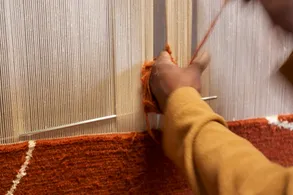
Casalis Rani Carpet
RANI CARPET
The use of the best-quality materials, such as wool from the Tibetan mountains and silk or bamboo, gives this hand-knotted rug not just primal strength but also softness and elegance.
DESIGNERS
STEFANIA RUGGIERO
Designer of our 'Rani Rock' design. Stefania Ruggiero, born in 1987, lives and works in Milano. Graduated in Product Design at Politecnico di Milano, she started as a carpet designer, and afterwards, she worked at Paola Navone and Marcel Wanders studio.
Currently, besides Casalis, Stefania also collaborates with companies like Londonart and HEMA. She has exhibited in group and solo shows including Camp Design Gallery and Nir Altman Gallery. Stefania acts between art and design, bringing poetry and experimentation to her projects.
LISET VAN DER SCHEER
Liset always tries to stretch the bounds of possibility. Looking at colour has become her second nature and in building designs be it for textiles or carpets, her starting point is always the expression of the yarn.
After graduating from the Design Academy in Eindhoven she has been working as an independent industrial textile designer and colour expert.
'The importance of designing to me lies in marketing a product that adds to the identity that the consumer wishes to convey at a particular moment in time. In my designs, the challenge lies in applying traditional materials in an innovative way, or in applying new materials to an existing production process. I always try to stretch the bounds of possibility. Looking at colour has become my second nature, and in building designs, be it textiles or carpets, the starting point is always the expression of the yarn'.
ONNO RAADERSMA
Producing designs is more than just a job for the Dutchman Onno Raadersma. It is his talent and his passion. This is obvious from the highly graphic nature of his designs that combine a penchant for light Scandinavian design with a fascination for traditional shapes and the use of hand-drawn and floral motifs.
His graphically ornamental designs, therefore, exude an unmistakably contemporary feel.
It is hardly surprising that many manufacturers and stylists at home and abroad are keen to engage him as often as they can. But that does not stop him going his own way: he set up MO-Studio with Rotterdam photographer Magri Geerlinks and he also regularly exhibits his own collection at design fairs in Belgium, Germany, France and Italy, and beyond.
INFORMATION
RANI DESIGNS
The collection contains three flower designs.
MATERIAL BACK
Tibetan wool possibly combined with Chinese silk.
STRUCTURE BACK
Hand-knotted back
PRODUCTION METHOD
Hand-knotted.
THICKNESS
- Total Thickness : 12 mm.
- Exceptions : Rani silk
- Rani double : 14 mm.
PILE STRUCTURE
Combinations cut pile and loop pile
DISCOLOURING OF THE SUBFLOOR
The back of the carpet has no influence on the floor underneath.
FINISH
Longer sides have been edged finely with tibetan wool. On the shorter sides a thicker edging in tibetan wool.
RANI PLAIN
A the standard colours of the rani plain are the same as for the raja.
CHILD LABOUR
The production of casalis-carpets is carried out without the use of child labour.
POSSIBLE SHAPES
- Round
- Oval
- Polygonal
COLOUR DIFFERENCES
- Slight colour differences between yarn batches are characteristic of dying natural materials and consequently cannot be valid grounds for complaints.
- Tibetan wool is produced by hand in order to retain the lively character of the wool. Dying such a yarn resultsin a rich range of colour. A single-coloured Rani-carpet does not exist.
NON STANDARD COLOURS
- Based on our colour reference boxes.
- Based on a reference sample (e.g. piece of fabric).
- Size of the samples available: 18 x 38 cm. colour sample.
NON STANDARD DESIGNS
Other designs can be created side and pile height areas, cuts, structure areas or a combination of the possibilities mentioned.
DEVIATIONS TO SIZE AND SHAPE
Casalis carpets are hand made. Shape and size can differ slightly. Therefore don't have the edges of the carpet lined up with any straight seams in the floor, but have the carpet cover them, so that any irregularities are not noticed.
RANI STRUCTURES
There are different line structures possible, in one or two colours. Rani silk and Rani double really come into their own in a single colour.
CRAFT & MATERIALS
COLORS






































